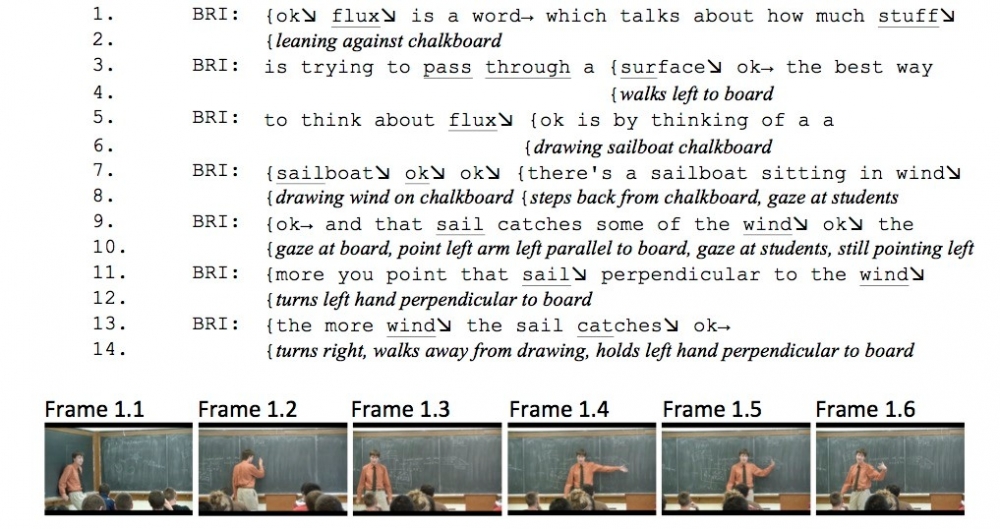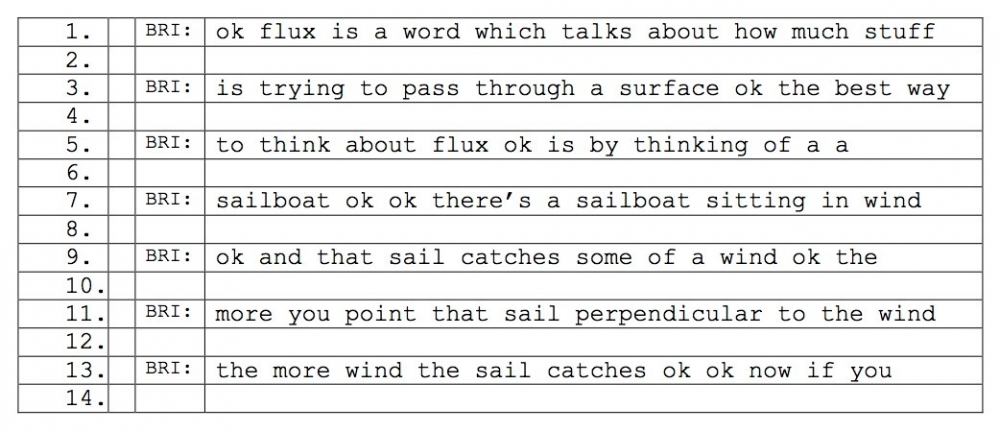|
In her keynote at the ITA Professional Symposium (The ITA
Professional Symposium was hosted by Carnegie Mellon University in
February 2017), Lauren Herckis referred to culture and teaching as
“invisible.” During the Q and A, I questioned her use of the term, but
the metaphor of invisibility re-emerged throughout the remainder of the
discussion showing that many in attendance agreed with the idea that
culture, language, and teaching are invisible. I found this stance
ironic considering the common practice in our field of using of video
and transcription. In fact, the issue that our ITAs face is not that
language and teaching are invisible. It is that language and teaching
are in the moment happenings that cannot be recovered verbatim from
memory. In addition, potential ITAs often lack the conceptual framework
and tools to analyze, discuss, and reflect upon teaching and
interaction.
In this article, I will briefly discuss the use of video and
transcription to make language and teaching visible. I will then analyze
a transcribed excerpt from a university mathematics course, drawing
attention to the interplay between prosody and gesture, and discuss how
the excerpt might be used in ITA preparation. I point out that while
language and teaching may be evanescent in the moment they are
nonetheless visible and made re-visible through the use of video and
transcription. Finally, I suggest that we do ourselves a disservice as a
profession by being lackadaisical in how we talk about language and
teaching.
Using Video to Make Language and Teaching Visible
The use of video has been suggested by or part of commercially
available texts for ITA preparation for decades (Gorsuch, Meyers,
Pickering, & Griffee, 2012; Meyers & Holt, 2002; Smith,
Meyers, & Burkhalter, 1992). Videos and transcripts are
particularly valuable resources for two reasons: they lend permanence to
language and teaching, and they enable us to highlight embodied
resources. First, they make the fleetingly audible and visible, i.e.,
language and teaching, re-visible. As Garfinkel (2002, p. 220) pointed
out in his study of a university Chemistry lecture, the action of the
classroom “cannot seriously be identified, formulated, or solved”
without “analyzable audio and video documents.” The details of language
and teaching are difficult to reconstruct from memory, but a digital and
written record of language and teaching gives us the ability to watch
and re-watch and analyze and re-analyze sequences of classroom
interaction. When we watch videos, we are able to notice even those
actions we missed in situ. Video and transcripts solve our dilemma with
the evanescence of language and teaching, so our next objective becomes
giving our students the concepts and vocabulary to analyze and reflect
upon what they see, and in turn to hopefully integrate (or not) what
they have seen into their own teaching.
So that becomes our task – developing a framework and lexicon
for our students to use to think and talk about language and teaching.
While ITA research and practice have developed robust frameworks for
understanding and teaching prosody (Gorsuch et al., 2012; Hahn, 2004;
Kang, Rubin, & Pickering, 2010; Meyers & Holt, 2002;
Pickering, 2001, 2004; Smith et al., 1992) embodiment is not well
researched in the ITA realm, which is likely the source of early
descriptions of lab interactions as “messy” (Myers, 1994). While some
face-to-face classroom situations may seem messy when we focus only on
lexis and morphosyntax, Goffman (1964, p. 136) observed that
“interaction […] has its own processes and its own structure, and these
don't seem to be intrinsically linguistic in character, however often
expressed through a linguistic medium.” From an embodied perspective,
participants interact not just through talk, but through mutual
orientation to a “temporally unfolding juxtaposition of multiple
semiotic fields,” including prosody, gesture, gaze, body position, and
the use of classroom artifacts (Goodwin, 2000, p. 1517; Mondada, 2016).
Video gives us direct access to the embodied resources used in teaching
that are often overlooked when we focus on language only in terms of
lexis and morphosyntax. As ITA trainers, we must draw our students’
attention to the “complex multimodal Gestalts” (Mondada, 2016) formed by
the co-occurrence of talk, gesture, gaze, facial expression, and the
use of objects in the environment. In the following two sections, I will
discuss how we can do so.
A Brief Analysis of Prosody and Embodiment While Introducing a Term
Excerpt 1 is from a university calculus course taught by Brian
(pseudonym). For more explanation of the broader study, participants,
etc., see Looney, Jia, and Kimura (2017). The analysis unpacks how Brian
uses various linguistic and non-linguistic resources to explain a
field-specific term. The excerpt occurred near the opening of an
explanation of the term “flux.” During Brian’s introduction of the term,
he enacts many suggestions for teaching that we see in the
aforementioned ITA training texts, e.g., use concrete examples, clear
thought groups, and multimodal resources. In Excerpt 1, the
transcription conventions note final falling and continuing rising tones
(↘ and →), prominence (underlined text), and embodied resources
(aligned with talk by { and written in Times New Roman). While the
excerpt presented here is short, the actual explanation of the term is
quite long and involves multiple concrete examples.
Excerpt 1 – “Flux is a word"

Click to enlarge
Just before Excerpt 1, Brian was leaning against the chalkboard
and informally introducing the term flux in the context of a popular
science fiction movie from the 1980’s (Frame 1.1). Brian then gave a
brief definition of flux in lay terms (lines 1 and 3). Note the stress
and falling intonation that he placed on the words flux, stuff, pass
through, and surface to create distinct intonational units and highlight
new information (Pickering, 2001).
As Brian concluded his layperson definition, he walked toward
the chalkboard and began drawing a sailboat (lines 4-6, Frame 1.2). As
he was drawing, Brian verbally presented students with the concrete
example of a sailboat (lines 3-7). Even though he was facing away from
the students momentarily, Brian spoke in clear thought groups and used
intonation to emphasize key information. He then turned back to his
students and began expanding upon his example (lines 7-8, Frame 1.3). In
lines 8-13, Brian stated that the more perpendicular the sail is to the
wind the more wind the sail catches. As he was speaking, his hand first
pointed in the direction of the wind he had drawn on the board then he
turned his hand, representing the sail he was speaking of, perpendicular
to the wind (Frames, 1.4, 1.5, 1.6). In sum, we can subdivide the above
excerpt into three moves: layperson definition, introduction of
concrete example, and explanation of concrete example. We see that Brian
used linguistic, prosodic, and embodied resources to construct his
explanation. Prosodic and embodied resources, i.e., intonation, stress,
gesture, and the chalkboard, were particularly important because they
subdivided and highlight important information.
From Analysis to Application
This analysis, though brief, is useful for teachers trying to
help potential ITAs see and discuss language and teaching. While a
detailed transcript is useful for the teacher and eventually the
student, I suggest starting with a broadly transcribed transcript with
line numbers and space for students to make notes (see Excerpt 2).
Courier New is a great font for making transcripts because each letter,
symbol, and space are the same width. The line numbers and simplified
transcription create an artifact that students can use to code different
parts of the explanation. For instance, we could code lines 1 and 3 as
“layperson definition,” lines 3-7 as “introducing a concrete example,”
and lines 7-13 as “expanding upon a concrete example.”
Excerpt 2 – “Flux is a word” for classroom use

Click to enlarge
Within the subsections that we have identified, we can analyze
and discuss prosody and embodied resources. This is where the vocabulary
from discourse intonation and CA will be particularly handy. In terms
of prosody, there are three features that I find this clip particularly
useful for: thought groups, prominence, and final falling (or
rising-falling) intonation. Students can work in groups or individually
to identify the thought groups, prominent words, and intonation
contours. Students can also identify and describe the embodied resources
they notice. This excerpt would be particularly useful for explaining
and analyzing the use of the chalkboard and gesture. After students have
completed their analyses, have them share and discuss them as a class.
This is where the detailed transcript in particularly useful especially
because it illuminates the complex interplay between talk and embodied
resources. After the discussion, students can use their analysis as a
micro-template for their own assignment of introducing a term or
concept. There could be other uses for this recording as well, e.g., a
fluency exercise using shadowing. In addition, video can be a useful
tool for helping provide feedback on ITA performance in role plays and
micro-teaching.
Conclusion
Conversation Analysis and related disciplines such as
interactional sociolinguistics and linguistic anthropology have made
readily apparent that language and teaching are visible and analyzable.
At the same time, ITA practice has, if only implicitly, reflected the
stance that language and teaching are visible by using video recordings.
Nonetheless, we are prone to speak of language as invisible because of
its apparent evanescence in our day to day existence. While words like
invisible are easy to use to describe language, we do so at our own, as
well as our students’, peril. Calling language and teaching invisible
perpetuates myths about language and teaching as individual and innate
traits instead of culturally-situated actions and practices that can be
developed through structured mediation. Adjectives like unappreciated or
unnoticed better describe language and teaching, and would be more
useful for us when speaking to those outside ITA practice. As language
teachers who often work with relatively high proficiency learners, it is
our responsibility to provide students with the concepts and terms to
analyze, reflect upon, and discuss language and teaching. We must help
them talk and think about what they see every day. We are not helping
them see the invisible, but helping them notice the
overlooked.
References
Garfinkel, H. (2002). Ethnomethodology’s Program:
Working Out Durkheim’s Aphorism (A. W. Rawls Ed.). New York:
Rowan and Littlefield.
Goffman, E. (1964). The neglected situation. American
Anthropologist, 66(6/2), 133-136.
doi:10.1525/aa.1964.66.suppl_3.02a00090
Goodwin, C. (2000). Action and embodiment within situated human
interaction. Journal of Pragmatics, 32, 1489-1522.
Gorsuch, G., Meyers, C., Pickering, L., & Griffee, D.
(2012). English Communication for International Teaching
Assistants (Second ed.). Long Grove, IL: Waveland
Press.
Hahn, L. D. (2004). Primary stress and intelligibility:
research to motivate the teaching of suprasegmentals. TESOL
Quarterly, 38(2), 201-223. doi:10.2307/3588378
Kang, O., Rubin, D. L., & Pickering, L. (2010).
Suprasegmental measures of accentedness and judgments of language
learner proficiency in oral English. The Modern Language
Journal, 94(4), 554-566.
doi:10.1111/j.1540-4781.2010.01091.x
Looney, S. D., Jia, D., & Kimura, D. (2017).
Self-directed okay in mathematics lectures. Journal of
Pragmatics, 107, 46-59. doi:https://doi.org
/10.1016/j.pragma.2016.11.007
Meyers, C., & Holt, S. (2002). Success with
Presentations. Burnsville, MN: Aspen Productions.
Mondada, L. (2016). Challenges of multimodality: Language and
the body in social interaction. Journal of Sociolinguistics,
20(3), 336-366.
Myers, C. L. (1994). Question-based discourse in science labs:
issues for ITAs. In C. G. Madden & C. L. Myers (Eds.), Discourse and Performance of International Teaching
Assistants (pp. 83-102). Alexandria, VA: Teachers of English
to Speakers of Other Languages.
Pickering, L. (2001). The role of tone choice in improving ITA
communication in the classroom. TESOL Quarterly,
35(2), 233-255. doi:10.2307/3587647
Pickering, L. (2004). The structure and function of
intonational paragraphs in native and nonnative speaker instructional
discourse. English for Specific Purposes, 23(1),
19-43. doi:http://dx.doi.org/10.1016/S0889
-4906(03)00020-6
Smith, J., Meyers, C., & Burkhalter, A. (1992). Communicate: Strategies for International Teaching
Assistants. Long Grove, IL: Waveland Press.
Stephen Daniel Looney is the ITA Program Director and
Senior Lecturer in the Department of Applied Linguistics at Penn State.
He is the current Chair of the ITA-IS, and his research focuses on L1
and L2 use in the university STEM classroom. |

